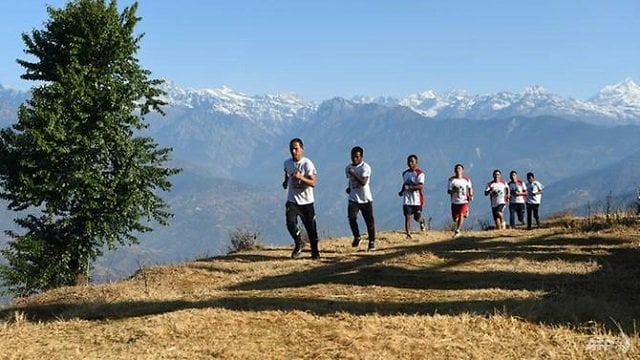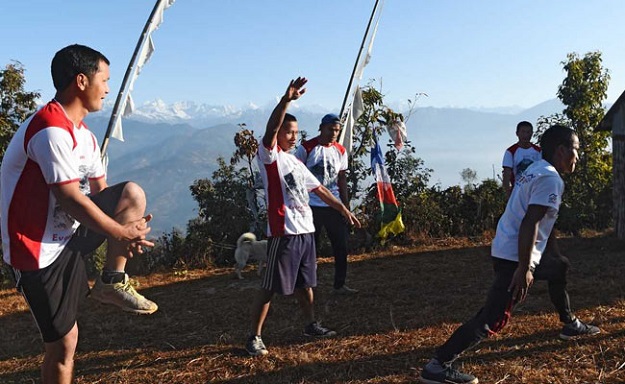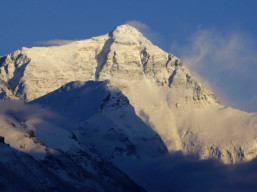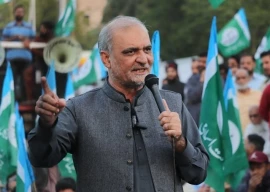
SINDHUKOT: Swapping their maroon robes for running shoes, seven Buddhist monks take off at a sprint across the hills surrounding their remote village in the foothills of Nepal's Himalayas.
PM Abbasi arrives in Kathmandu for two-day official visit
They are aspiring ultra-marathon runners, hoping the sport will put their remote village on the map and provide the funds needed to rebuild homes destroyed by a massive earthquake nearly three years ago.
"We found out that we can get many opportunities through running and hope to do something from our monk team -- make a name for our village and bring development here. That is why we are running," says Man Bahadur Lama, 21, the fastest of the group.
The monks -- most of them in their early twenties -- follow a strict regime, praying in the morning before disappearing into the hills to run up to 40 kilometres (25 miles) each afternoon.
Life is tough in Sindhukot village, which lies just 80 kilometres from Kathmandu but like many rural communities in impoverished Nepal feels totally cut off from the rest of the world. The nearest school is a two-hour walk and the only shops are in a neighbouring village.
Many Buddhist families in Nepal send at least one son to join the local monastery, where they are usually fed, clothed and educated -- relieving their parents of the financial burden.
Lama was sent away when he was just eight, but is currently living back at home as the village monastery was destroyed in the 2015 earthquake.
Fellow monk Mingma Lama is matter-of-fact about his new pursuit, which he says his monastic duties in the community have prepared him for. "Every day we go up and down the hills. We often have to walk far... So running wasn't too hard for us," he said.
These Himalayan monks are not the first to take up running. The so-called 'marathon monks' of Mount Hiei in Japan are known for their superhuman feat of running 1,000 marathons in 1,000 days -- but they are seeking enlightenment not prize money.
Mingma Gyalbo, a member of the monastery who also organises races nearby, said the monks are talented but need more support to excel. "They don't have the technical know-how, like for their diet, or even proper shoes for running," Gyalbo said.
Trail running and ultra marathons are gaining popularity in Nepal, where the Himalayan terrain lends itself to extreme tests of human endurance.
 Trail running and ultra marathons are gaining popularity in Nepal, where the Himalayan terrain lends itself to extreme tests of human endurance. PHOTO: AFP
Trail running and ultra marathons are gaining popularity in Nepal, where the Himalayan terrain lends itself to extreme tests of human endurance. PHOTO: AFPNepal now hosts a handful of races each year, including the world's highest marathon that starts at Mount Everest base camp at a breathless altitude of 5,364 metres.
A few Nepali runners have made their mark internationally, like former child soldier Mira Rai who recently won the gruelling 52 kilometre Ben Nevis Ultra in Scotland and was named National Geographic Adventurer of the Year in 2017.
The Sindhukot monks' first race was two years ago, a 30 kilometre trail run in a neighbouring village. But they are yet to win any medals.
The fastest monk, Man Bahadur, came tenth in their first major marathon earlier this month, missing out on the top prize of 100,000 rupees ($964) -- more than the average annual income in Nepal.
Nepal’s teenage sensation eager to make history in IPL
He said running in flat and hot Lumbini, Buddha's birthplace in southern Nepal, was very different to their hilly home terrain. "I was quite amazed when I first learned that these monks were running," said race organiser Shekhar Pandey.
"They are very self-motivated and hardworking, they are training by themselves. They are very young and if they train well they have good potential."
Chuldim Sampo, 24, said the monks were excited. He explained: "We want to show people that even monks are capable of running."























































COMMENTS (1)
Comments are moderated and generally will be posted if they are on-topic and not abusive.
For more information, please see our Comments FAQ